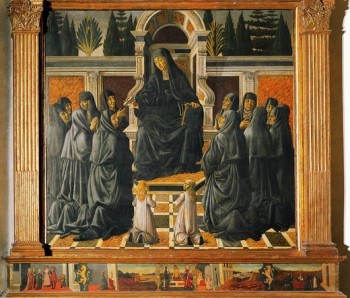
Laura's Blog

The Kick-Butt Abbess
October 21, 2015
It was at Le Murate convent that Ginevra grew into the woman Leonardo would end up painting, and the poet we know from that dazzling one line of hers that remains: “I beg your pardon, I am a mountain tiger.”
And I think Abbess Rondinelli had a great deal to do with that blossoming.
In Renaissance Italy, only twelve percent of women were literate. Think about this in the most basic terms—the overwhelming majority of women (almost 9 out of 10) could not read or write even their own names.
Upper class girls’ education was designed to prepare them to run a household, maintain a religiously devout home, and to be conversational hostesses. They studied dancing, singing, etiquette, cooking, and basic nursing. Affluent families might also send their girls to convents as boarders to “learn the virtues,” i.e. chaste, modest deportment and attitudes, their catechism, and feminine skills like needlework. They would emerge as marketable brides, devout, dignified, and self-contained.
But some convents also became intellectual havens, the mini-Sweetbriars and Bryn Mawrs of their time. Le Murate was foremost one of them. Thanks to a courageous and worldly abbess named Scolastica, Ginevra was also taught to read, and to read Latin--which gave her access to ancient “pagan” poets and philosophers, in addition to the bible and 14th century Italian writers like Dante.
Scolastica joined the convent after her husband died, as did many widows for financial reasons. She brought two young daughters with her. She changed her name from Cilia to Sister Scolastica! (which is Latin, of course, for female scholar). What a self-statement, right?
Within two years, she was running the place.
Scolastica pushed the envelope dangerously in teaching her students to read Latin, which gave them access to all sorts of non-traditional ideas and legends. She also allowed nuns to own books and to read them aloud at dinner to their fellow sisters. She encouraged their creativity. They wrote poems and devotional plays that were performed at holidays. Women began to flock to her sanctuary. During her 36-year tenure as mother superior, the number of nuns at Le Murate doubled from 80 to more than 150.
Not only was she progressive, even a little feminist, Scolastica had a great head for business. Under her leadership the convent began copying and illustrating manuscripts, and producing exquisite needlework and linens that wealthy Florentines rushed to purchase for their daughters’ trousseaus.
The once beautiful, well-dressed woman-of-the-world also knew to tap into the city’s thirst for luxury fabrics. Scolastica made Le Murate the first convent to manufacture gold thread, becoming an integral part of Florence’s silk industry. The irony, of course, is that women who had forsaken all earthly wealth produced thread for the most sumptuous of clothes. Somehow, Scolastica managed that tightrope walk with the Church’s higher authorities and used the income to buy books. She even purchased an organ to accompany her flock in singing, plus hired a tutor to help them learn Gregorian chants AND polyphony (music with harmony, multiple lines of notes, which was considered quite scandalous at the time!)
She got away with it, because Scolastica knew how to work politics. She convinced not only the Benci family to spend thousands of florins on the convent, she sweet-talked Lorenzo de’ Medici into sending regular gifts of food and oil, even marzipan for sick nuns.
Creating essentially a girls college that kept daughters safe and chaste while they studied cultivated an advantageous closeness with Florence’s well-born families. Scolastica extended that into those girls’ adulthood by also creating an “order of lay sisters,” or conversa, devout women who could come in and out of the convent when they needed “spiritual refreshment.”
That access is something that clearly became very important to Ginevra, who retreated and re-emerged from Le Murate repeatedly over her life, finally being buried within its walls at her death. Did she go for the safe, intellectual discourse allowed within those walls, free from male rules or put-downs? Many women like her did.


Other Blog Posts
Click Here to See All of Laura's Blog Posts
